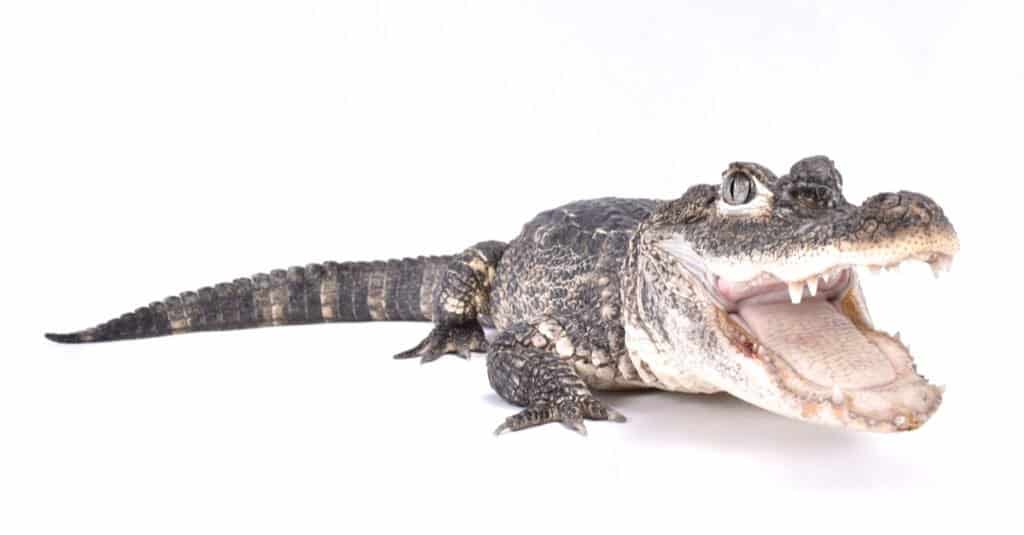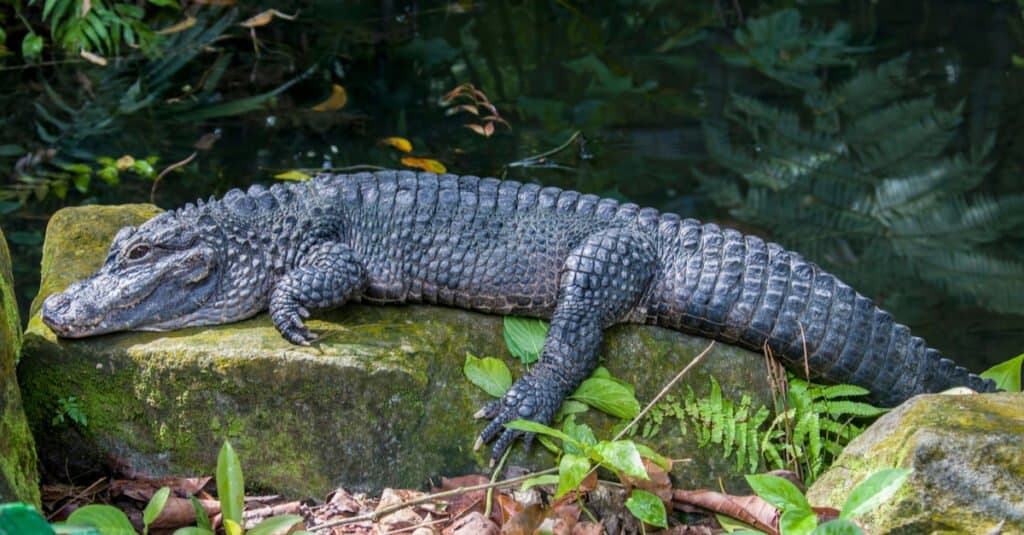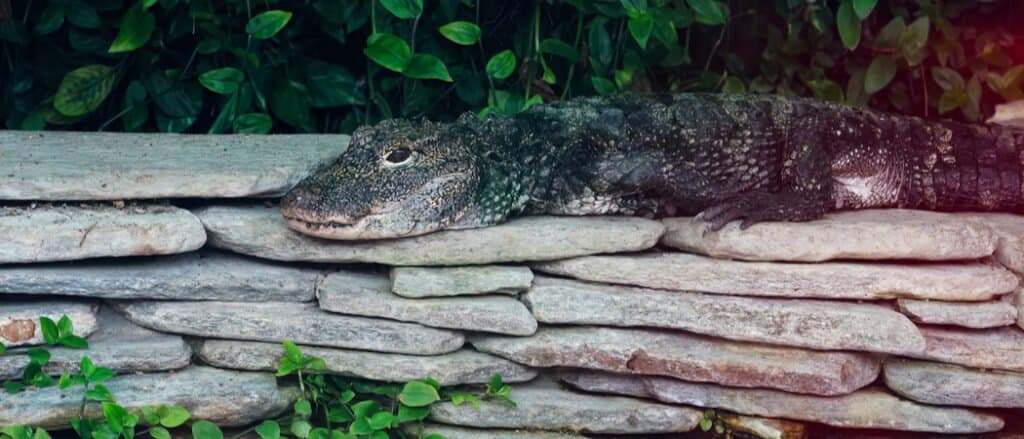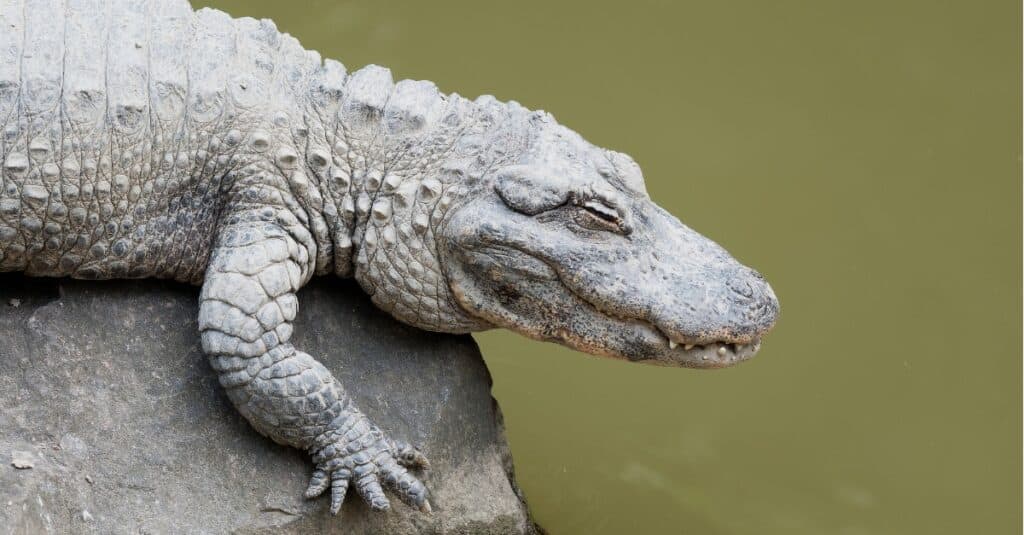Chinese Alligator
Alligator sinensis
Unlike other alligators, the Chinese alligator is armored all over, even on its belly.
Advertisement
Chinese Alligator Scientific Classification
- Kingdom
- Animalia
- Phylum
- Chordata
- Class
- Reptilia
- Order
- Crocodilia
- Family
- Alligatoridae
- Genus
- Alligator
- Scientific Name
- Alligator sinensis
Read our Complete Guide to Classification of Animals.
Chinese Alligator Conservation Status
Chinese Alligator Facts
- Prey
- Small mammals, water birds, fish, aquatic mollusks; hatchlings eat insects, spiders and other invertebrates.
- Name Of Young
- Hatchling
- Group Behavior
- Sociable
- Fun Fact
- Unlike other alligators, the Chinese alligator is armored all over, even on its belly.
- Estimated Population Size
- 100-150 in the wild; 20,000 in captivity
- Biggest Threat
- Humans
- Most Distinctive Feature
- Osteoderms on its belly
- Other Name(s)
- China alligator, muddy dragon, Yow Lung, T’o, Yangtze alligator
- Gestation Period
- Females gravid for a little over a month
- Litter Size
- 10-40 hatchlings
- Habitat
- Subtropical wetlands, rivers, streams, lakes, ponds, and swamps
- Predators
- Humans
- Diet
- Carnivore
- Type
- Reptile
- Common Name
- Chinese alligator
- Number Of Species
- 1
- Location
- Yangtze River basin, China
- Group
- Congregation
View all of the Chinese Alligator images!
At any one time, the Chinese Alligator can have as many as 80 teeth in its mouth. It’s constantly losing them but the lost teeth are continually replaced.
If an alligator can be said to be peaceable, the Chinese alligator is it. It spends its winters brumating or undergoing the reptile version of hibernation. During the warmer months, it basks in the sun since it’s cold-blooded, but hunts at night, largely to avoid humans, its only predator. Still, the Chinese alligator’s attempts to steer clear of humanity have only been partially successful, for its conservation status is critically endangered. The animal is hunted for its meat and internal organs, which some believe to have medicinal qualities. Since the skin on its belly is full of bones, it’s not hunted for leather as other crocodilians are.

5 Incredible Chinese Alligator Facts!
- The Chinese alligator is the only alligator found outside North, Central, and South America.
- This alligator digs burrows, some of which are extensive, with multiple rooms and even indoor swimming pools.
- Like many other reptiles, the sex of a hatchling is determined by the incubation temperature. Lower temperatures produce females, and higher temperatures produce males.
- Chinese alligators can’t reproduce after their 50s.
- The population of the formerly abundant Chinese alligator began declining around 5,000 BC thanks to human activity.

The Chinese alligator is the only alligator found outside of North, Central, and South America.
©iStock.com/zhnger
Scientific Name
The Chinese alligator’s scientific name, Alligator sinensis, is as simple as can be. Alligator is actually from the Spanish el lagarto, which means “the lizard” and sinensis is Latin for “from China.”
It is also commonly known as the Yangtze alligator for its habitat as well as historically referred to as the muddy dragon.

The Chinese alligator’s scientific name is
Alligator sinensis.
©reptiles4all/Shutterstock.com
Evolution and Origins
The Chinese alligator is the only one of its species and it and its closest relative, the American alligator, both belong to the Alligator genus.
Chinese alligators have been referenced in Chinese literature since at least the third century. Marco Polo was the first outside of China to mention the animals after seeing them in the late 1200s. French naturalist Albert-Auguste Fauvel described them in 1879 with their scientific name. In the early 1900s, a popular theory was that the Chinese alligator inspired the mythological Chinese dragon that symbolized royalty and good luck, was able to move through air and water, and often helped and rescued people.
The earliest fossil evidence of the Chinese alligator dates from about 3 million years ago during the late Pliocene in Japan. Fossils also indicate that the alligator’s range was bigger, stretching north to Shandong and south to the Taiwan Strait.

The Chinese alligator and American alligator belong to the same genus.
©iStock.com/Cindy Larson
Appearance
The Chinese alligator is a much smaller alligator than its American cousin. The length of the animal ranges between five and seven feet, while the American alligator can grow to more than 11 feet. The adults are gray or black, while hatchlings are lighter and speckled. They are different from American alligators in that their feet, with five toes, are not webbed. They have osteoderms on the belly and their snouts turn up the way the snouts of American alligators do not. They also have a plate of bone in both of their upper eyelids, and their tail is wider than the tail of the American alligator.
The teeth of the Chinese alligator are not particularly sharp, but they have a lot of them. At any one time, the animal can have as many as 80 teeth in its mouth. It is constantly losing them but the lost teeth are continually replaced.

The Chinese alligator can reach a length of up to seven feet..
©Danny Ye/Shutterstock.com
Behavior
The alligator spends at least a few months out of the year brumating in its burrow. These burrows can be big, with rooms large enough for the animal to turn around in. They are sometimes shared with at least one other alligator. Females build their nests close to their burrows to keep an eye on their eggs and hatchlings. When the weather warms, the alligator ventures out into the sun to bask, and in the spring and summer, it is warm enough to hunt at night and eventually find a mate.
Chinese alligators advertise their location to other alligators through roars, bellows, and hisses. They also snap their jaws and use their lower jaw to slap the water. During the mating season, males cause vibrations in the water that are attractive to females and that a human can just barely hear. Baby alligators also make sounds to communicate with their mother, even when they’re in the egg.

In warm weather, the Chinese alligator will leave its burrow.
©HWall/Shutterstock.com
Habitat
Chinese alligators live in bodies of freshwater in the Yangtze River basin, thus giving them their other name of Yangtze alligator. Though their habitat range was once wide, they are now confined to only six counties in the area. The climate there is right on the edge of tropical and subtropical. The alligators used to live at the bottom of the mountains but habitat loss has forced many to move north, where it is sometimes too cool for their eggs to be properly incubated.

Chinese alligators are also called Yangtze alligators after their habitat.
©yanjf/Shutterstock.com
Diet
The Chinese alligator is the apex predator where it lives and is an opportunistic carnivore predator that will eat any animal it can handle. Because the alligator is small, it eats smaller animals such as ducks, rats, and other rodents, fish, snails, aquatic crustaceans, amphibians, and insects. Insects and snails are especially popular with young alligators.

The Chinese alligator will prey upon small animals such as ducks.
©Christian Musat/Shutterstock.com
Predators and Threats
One of the sadder facts of Chinese alligator life is that their only real predator is the human. Humans used to eat the Chinese alligator and may still do so illegally. The meat was a delicacy and, until surprisingly recently, some diners actually thought they were eating the flesh of a real dragon.
People also not only hunt them but destroy their habitat through the building of dams and rice paddies. The alligator was even accidentally killed by a poison meant to kill snails. Now, it is legally protected, and killing and capturing a wild Chinese alligator is forbidden. The Chinese government created the Anhui National Nature Reserve for Chinese Alligator in 1982, which, at nearly 46,000 covers the animal’s range.
Hatchlings are targeted by natural predators such as fish, large birds, or even other alligators.

The development of rice paddies caused habitat loss for the Chinese alligator.
©iStock.com/Trail Sun
Reproduction, Babies, and Lifespan
Chinese alligators are ready to breed when they’re between five and seven years old. They mate during the rainy season, which is in June. Males and females bellow and roar to each other to let each other know of their location and release an alluring musk from a gland just under their lower jaw. Females also slide up against a male to let him know she’s ready. She will only mate with one male a season, and she will only mate with him if he’s larger than she is.
After her eggs are fertilized, the female carries them for about a month and then starts to build a nest made of vegetation and mud on the banks of the body of water near her burrow. She lays between 10 and 40 surprisingly small eggs, then covers them up with vegetation. The heat given off by the decomposing vegetation incubates the eggs. The female protects the eggs, and they hatch in September.
Before they hatch, the baby alligators call from inside their eggs to let their mother know to uncover them. She will then, with great tenderness, carry the hatchlings in her otherwise fearsome mouth to the water. She may even, also with tenderness, crack the eggshell in her mouth if the hatchling is having trouble getting out. The mother alligator not only does this but continues to protect her babies until the winter.
Chinese alligators live about 50 years in the wild but have been known to live up to 70 years in captivity.

Juvenile Chinese alligators grow to weigh 80-100 pounds when they mature.
©Andy Crocker/Shutterstock.com
Population and Conservation
The population of Chinese alligators is classified as Critically Endangered on the IUCN’s Red List, which means the animal is basically on the edge of extinction.
As of 2021, there is a population of between 100 and 150 Chinese alligators left in the wild. However, they are being successfully bred in such places as the St. Augustine Alligator Farm and the Bronx Zoo. These zoos and other organizations are helping to restore the wild population of these alligators. There are now about 20,000 Chinese alligators in captivity.
View all 235 animals that start with CChinese Alligator FAQs (Frequently Asked Questions)
Are Chinese alligators carnivores, herbivores, or omnivores?
Chinese alligators are carnivores and eat smaller animals such as rodents and waterbirds such as ducks. They also eat mollusks, crustaceans, insects, and other invertebrates.
How big are Chinese alligators?
Chinese alligators are smaller than American alligators and range between 5 and 7 feet in length.
Are Chinese alligators aggressive?
Chinese alligators are not at all aggressive toward humans, but they are sometimes aggressive toward each other. They have been known to eat the hatchlings of their species! Unfortunately, human activity has caused the animal to become critically endangered.
What does a Chinese alligator look like?
A Chinese alligator has four legs with five toes, a long tail, a long, somewhat upturned snout, and a hide made largely of osteoderms, or skin covered with bone. Its colors range between yellowish gray and black, and its mouth contains about 80 teeth at one time that are constantly being lost and replaced.
Thank you for reading! Have some feedback for us? Contact the AZ Animals editorial team.
Sources
- Experience Kissimmee Florida, Available here: https://www.experiencekissimmee.com/blog/7-alligator-facts-you-probably-didnt-know
- IUCN Red List, Available here: https://www.iucnredlist.org/species/867/3146005
- UNESCO, Available here: https://whc.unesco.org/en/tentativelists/106/
- St. Augustine Alligator Farm, Available here: https://www.alligatorfarm.com/blog-item/chinese-alligators/
- WCSNewsroom, Available here: https://newsroom.wcs.org/News-Releases/articleType/ArticleView/articleId/9363/Worlds-Most-Endangered-Alligator-Making-a-Comeback-in-Shanghai.aspx
- Integrate Taxonomic Information System, Available here: https://www.itis.gov/servlet/SingleRpt/SingleRpt?search_topic=TSN&search_value=202209#null

















